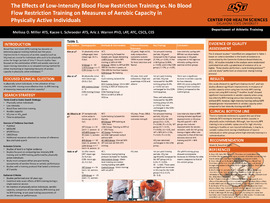| dc.contributor.author | Miller, Melissa O. | |
| dc.contributor.author | Schroeder, Kacee L. | |
| dc.contributor.author | Warren, Aric J. | |
| dc.date.accessioned | 2020-05-05T19:37:51Z | |
| dc.date.available | 2020-05-05T19:37:51Z | |
| dc.date.issued | 2020-02-28 | |
| dc.identifier | ouhd_miller_effectsoflowintensityblood_2020 | |
| dc.identifier.citation | Miller, M. O., Schroeder, K. L., & Warren, A. J. (2020, Feb. 28). The effects of low-intensity blood flow restriction training vs. no blood flow restriction training on measures of aerobic capacity in physically active individuals. Poster presented at Research Day at Oklahoma State University Center for Health Sciences, Tulsa, OK. | |
| dc.identifier.uri | https://hdl.handle.net/11244/324225 | |
| dc.description.abstract | Background: Blood flow restriction (BFR) training has become an extremely popular training method over the years. Improvements in measures of aerobic capacity (such as VO2max) are crucial for individuals whom seek to be physically active for longer periods of time. Recent studies have focused on the combination of BFR and aerobic exercise at lower training intensities as an adapted training method for either maintaining or improving measures of aerobic capacity in physically active individuals. | |
| dc.description.abstract | Clinical Question: In physically active individuals, is low-intensity blood flow restriction training more effective than no blood flow restriction training at improving measures of aerobic capacity? | |
| dc.description.abstract | Methods: A computer-assisted literature search of PubMed, MEDLINE, SPORTDiscus, and EBSCOHost databases (from inception to November 2019) was utilized to identify studies of level 3 evidence or higher that assessed the effect of low-intensity BFR training versus no BFR training on measures of aerobic capacity in physically active individuals. The main outcomes of interest were either pre-post testing assessments of aerobic fitness (such as VO2max or VO2peak) and/or pre-post testing assessments of aerobic performance (such as time to exhaustion). | |
| dc.description.abstract | Summary of Key Findings: The search strategy revealed 4 studies that met the inclusion criteria. One study reported that there were no significant improvements in measures of aerobic capacity when using low-intensity BFR training versus not using BFR training (1.96%, p < 0.05), while two studies reported that there in fact were significant improvements in measures of aerobic capacity (VO2max: 6.5%, p < 0.05 and TTE: 15.4%, p < 0.01; VO2max: +9.1± 6.2%, P < 0.001). One study reported that there were significant improvements in aerobic capacity when using low-intensity BFR training versus low-intensity training without BFR (BFR group: 5.6 ± 4.2%, P = 0.006, ES = 0.33; LOW group: 0.4 ± 4.7%, P = 0.75); however, high-intensity training without BFR showed greater improvements in aerobic capacity when compared to low-intensity training with BFR (HIT group: 9.2 ± 6.5%, P = 0.002, ES = 0.9). | |
| dc.description.abstract | Clinical Bottom Line: There is moderate evidence to support the use of low-intensity BFR training to improve aerobic capacity in physically active individuals. | |
| dc.description.abstract | Strength of Recommendation: Grade B evidence exists that low-intensity BFR training is more effective than no BFR training at improving measures of aerobic capacity in physically active individuals. | |
| dc.format | application/pdf | |
| dc.language | en_US | |
| dc.publisher | Oklahoma State University Center for Health Services | |
| dc.rights | The author(s) retain the copyright of have the right to deposit the item giving the Oklahoma State University Library a limited, non-exclusive right to share this material in its institutional repository. Contact Digital Resources and Discovery Services at lib-dis@okstate.edu or 405-744-9161 for the permission policy on the use, reproduction or distribution of this material. | |
| dc.title | Effects of low-intensity blood flow restriction training vs. no blood flow restriction training on measures of aerobic capacity in physically active individuals | |
| osu.filename | ouhd_miller_effectsoflowintensityblood_2020.pdf | |
| dc.type.genre | Presentation | |
| dc.type.material | Text | |
| dc.subject.keywords | low-intensity | |
| dc.subject.keywords | blood flow restriction | |
| dc.subject.keywords | bfr | |
| dc.subject.keywords | training | |
| dc.subject.keywords | aerobic capacity | |
